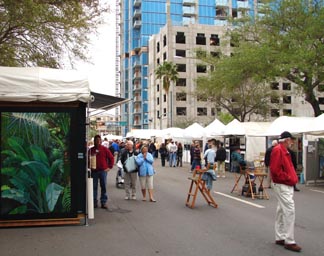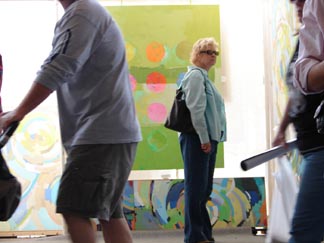I admit it. I have looked down on arts and crafts street fairs as a kind of subspecies of the artworld. The fairs are fully acceptable as cultural phenomena if composed of truly local makers, especially with ethnic or migrant identity. But not acceptable as a place for the educated artist as was defined historically in the 20th century by New York museums and galleries.

Images from Gasparilla Festival of the Arts, Tampa, Florida, March 3 & 4, 2007
Yet every winter weekend in Florida, an arts festival of talented artists fills the downtown, central streets and parks of several towns. In the state, only downtown Miami has no significant event. Some draw hundreds of thousands of people filling the streets, bars and restaurants to capacity.
As placemaking, the arts festival replaces the automobile with crowds between repetitive white, 10 x 10 x 8 tents. Inside the narrow zone, the eye of the walker or shopper is contained until the abrupt end of the row. Only the wind, sun or rain give any geography as the surrounding city is ignored. You are not “anywhere”, but you need to look up occasionally to remind yourself where you are.
The street fair does bring new sights on the city or park. Walkers turn and orient themselves from the less experienced locations in the center of the streets or “off the grass” park zones. Views of buildings emerge. Traffic islands are places, not dividers. A sense of enclosure is felt in center of the street that cannot be known on the typical edges with the moving cars in the middle. New self-initiated paths emerge across green and asphalt.
The view of the artist is a different view unknown to the tens of thousands of visitors. The artists learn the street intimately- its pitch, its potholes, its grease, its trash. Setting up at night, the artist leans psychologically and physically toward the dim electric bulbs of the streets or buildings. During the rain, the success or failure of the gutter brings relief or panic. The returning sun washes out colors or converts the artworks to dark silhouettes against the translucent plastic walls.
In general, the artists believe that sitting in the tent keeps the customer away, an attitude completely opposite of every other “in your face” pedestrian street market in the world. On closer observation, the larger the object, the more the artist disappears. Makers of jewelry assist all the lookers. Potters and glass blowers sit among their work. Painters peak out from behind a tent opening and only meet the people when approached and asked, “Are you the artist?” The difference seems related in part to theft as the painters of 10 x 6 canvases just abandon their tents completely after the judging for “best in show.”

As the thousands pass each hour, only a tiny few stop to look at any one tent. The larger the artwork, the less the visitors. This axiom is a function of purchasing power of the customers and the standardization of the tent in which all the large works can be seen from the street.
Regarding the view down my nose, these artists are artists and quite a special breed. They travel from their homes in the eastern half of the USA to live out of a van for 8-12 weeks in January, February and March. They come to SELL their work. Each show is crapshoot that might mean nothing or thousands of dollars. Being seen is regular stuff. Sales make the difference.

Artwork of Maria Foladori Weiss
Unlike those artworld artists, they are empowered. Yet they carry a kind of benign pessimism based in the economic reality of their lives.
These artists don’t wait to be discovered by a curator or picked up by a gallery. They act. They develop a direct relationship with their customers that can also become their collectors. They completely control the presentation of their work. And unlike the artworld artists – many of these artists might be seen by more than a million art-loving people a year.
At the end of the day, the 20th century artworld holds its trump card – the art is not art. If the artworld thinks so, then it is because they don’t go EVERY gallery in NYC each month to be drowned by the repetition of forms and because they don’t look at the art in the art festivals.
In the major Florida festivals, the artists are artists. Intense examination reveals the excellence in color, composition, materials and storytelling. Yes these artworks are not part of the contemporary artworld dialogue and therefore will not be a part of that conversation. Yes these artworks are not of the moment and could have been appreciated by different artlovers 20 years ago. Taking the long view – global warming and all – does that really matter beyond the momentary fun of the art conversation? These artists are tough and skilled.
I was proud to be among these artists as my wife attempted to directly find an audience and buyers for her paintings.
Public Art, Public Space

You make it sound as if there is a complete and total divide between “artworld” artists on the one hand, and “craft fair” artists on the other.
But there is certainly a gray area, a place where the yolk of the egg runs out all over everything.
Some of the craft fair stuff is indeed lowest common denominator stuff, carefully designed to appeal to non-art world tastes.
However, I have known several artists over the years who had respectable resumes, were collected in the right homes, and still prefered the immediate contact and lack of commissions that the fairs provide.
I used to know a guy in Ojai California who would drive to Florida every winter for a couple of months, and he would routinely come back with a hundred grand in cash. He sold major bronzes, abstract not figurative, for 10k and up.
His work was also shown in a few galleries, and he is considered to be “artworld” rather than street by the powers that be. But he liked the hucksterism, and he cultivated his own group of high rolling Florida noveau riche types who dont go to Chelsea. Tax free cash didnt hurt either.
And then there are the true craftspeople- unlike the handful of college professors we used to see displayed in the old Craft Horizons magazine, there are a lot of real craftsmen and women out there who just plain like making functional stuff. My old friend Charlie, who really enjoys making coffee mugs, is quite sophisticated in his work- his early 80’s “Dr. Seuss” series was reminiscent of, and came from the same sources as Ken Price’s work.
Charlie, however, got a positive rush out of selling 1500 mugs, for $25 each, in one three day craft fair. And much as he loved each mug, it satisfied his soul to be able to make them quickly, sell them cheap, and have them actually used.
The 95% rule, however, still applies- 95% of anything is crap, and this goes for craft fair artists just like it does for movie screenwriters or congressmen.
Art should communicate with the viewer, not ossify in state museums and galleries. Art should be about wonder, spirituality, humanity and life, not introverted examination of art itself. Interminable dissection and examination destroys as it explains.
Art is in the display of the object and not the creation of the object. Whether we like it or not the gallery or museum are intrinsic to the value (financial or critical) of the art object. The artist seeks the exhibition and the attention. They may not seek the associated celebrity status, they may not seek the extremes of financial reward that can be generated through engineered publicity but they do seek the exhibition of their work.
If these arenas are important, then they are important for a reason, and the only common reason is that it puts the notion of the creator of the work, as an artist, in the public domain.
Put plain and simply – recognition and/or communication with a public audience is what is sought when an artist works. Would an individual want to be recognized as an artist without consideration taken of the value of the work? Or again, put plainly, do they just want celebrity status for having work on display? Probably not, or at least that’s what most would claim. Most artists want their work to be evaluated by an audience and found to be worthy of entering the common memory (for whatever period of time) so art plainly has to engage with the audience at some point in the exhibitive process.